Discover the Best Robotic Process Automation Software (RPA) List for 2025 in our expertly curated list. Compare top RPA tools, features, and pricing to find the perfect automation solution for your business.
Robotic Process Automation (RPA) software simplifies tasks. It automates repetitive processes.
Businesses today seek efficiency and cost reduction. RPA software can handle mundane tasks, freeing up human resources for more complex activities.
With the right RPA tools, you can streamline operations, improve accuracy, and enhance productivity. As technology advances, the variety of RPA software grows, offering solutions for different needs.
This list explores top RPA software to help you choose the best fit for your organization. Discover how these tools can transform workflows and boost your business efficiency.
Let’s dive into the world of RPA and find the ideal software for your automation needs.
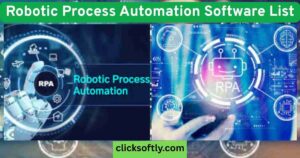
Introduction To Rpa Tools
In today’s fast-paced digital world, businesses are constantly seeking ways to boost efficiency and cut costs. One powerful solution that has emerged is Robotic Process Automation (RPA). RPA tools can handle repetitive tasks, freeing up human employees to focus on more strategic work. Let’s dive into what RPA is and why it will be even more crucial by 2025.
What Is Robotic Process Automation?
Robotic Process Automation, or RPA, involves using software robots or ‘bots’ to automate mundane and repetitive tasks. These tasks can range from data entry to invoice processing, all without human intervention.
Imagine a bot that logs into your systems, extracts data, and updates records – all in a matter of seconds. It’s like having a super-efficient assistant who never sleeps or makes mistakes.
RPA tools can integrate with various applications and systems, making them highly versatile. Whether you’re in finance, healthcare, or customer service, there’s likely an RPA tool that can make your job easier.
Read our blog post!
Importance Of Rpa In 2025 | Robotic Process Automation Software (RPA) List
As we look towards 2025, the importance of RPA will only grow. One key reason is the increasing need for businesses to operate efficiently in a competitive market. Automation can be the difference between thriving and merely surviving.
Consider how much time your team spends on tasks like data processing. Now, imagine if that time could be redirected towards innovation and customer engagement. RPA makes this possible.
Moreover, with advancements in AI and machine learning, RPA tools are becoming smarter and more capable. They can learn from data and improve their performance over time, making them invaluable assets for any business.
Have you ever thought about how much potential is wasted on routine tasks? RPA is not just a trend; it’s a transformative technology that will shape the future of work. Are you ready to embrace it?
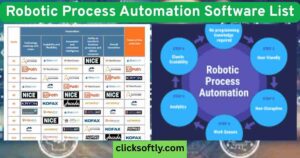
Key Features Of Rpa Software
Robotic Process Automation (RPA) software has transformed the way businesses handle repetitive tasks. This technology brings numerous advantages, but understanding its key features is crucial for making an informed decision. In this section, we will delve into the essential attributes that make RPA software a game-changer.
Automation Capabilities, Best Robotic Process Automation Software (RPA) List
One of the standout features of RPA software is its automation capabilities. These tools can execute tasks tirelessly, eliminating human errors and speeding up processes. Imagine never having to manually transfer data between spreadsheets again.
RPA software can handle complex workflows with ease. From data entry to invoice processing, these tools can manage it all. You can focus on strategic tasks while the software takes care of routine operations.
Another benefit is scalability. Whether your business is small or large, RPA can adjust to your needs. As your operations grow, the software can handle increased volumes without extra costs.
Integration With Existing Systems
Seamless integration with existing systems is another key feature of RPA software. This means you don’t have to overhaul your current IT infrastructure. The software works with your existing applications and databases.
For instance, RPA can integrate with CRM systems, ERP platforms, and even legacy systems. This reduces the need for extensive training and minimizes disruptions to your workflows.
Moreover, RPA software often comes with built-in connectors. These connectors enable quick and easy integration, saving you time and effort. You can get your automation up and running without lengthy setup processes.
Choosing the right RPA software depends on understanding these key features. Consider how automation capabilities and integration options can benefit your specific operations. What tasks could you automate to free up time for more strategic activities?

Best Robotic Process Automation Software (RPA) List
As we approach 2025, Robotic Process Automation (RPA) continues to transform the way businesses operate. It’s fascinating to see how RPA tools evolve and adapt to meet growing demands. If you’re looking to stay ahead, understanding the top RPA tools for 2025 is crucial.
Leading Rpa Software Providers
Some RPA tools have proven their worth over the years, offering robust and reliable solutions.
UiPath remains a popular choice. It’s known for its user-friendly interface and extensive capabilities. Businesses appreciate its ability to automate complex tasks with ease.
Automation Anywhere is another key player. It excels in providing scalable solutions, perfect for both small businesses and large enterprises. Their cloud-based platform is particularly appealing in today’s remote work environment.
Blue Prism also deserves mention. It’s highly regarded for its strong security features. Companies handling sensitive data find Blue Prism’s compliance features reassuring.
Emerging Rpa Solutions
While established tools are reliable, it’s worth exploring new entrants shaking up the market.
Electroneek is gaining traction. It offers a cost-effective solution with powerful automation capabilities. Startups and SMEs find its pricing model particularly attractive.
WorkFusion integrates AI seamlessly into RPA. This combination allows for intelligent automation, making it a preferred choice for businesses looking to leverage AI.
Another rising star is Kryon. It stands out with its unique process discovery feature. This helps businesses identify automation opportunities quickly and efficiently.
Have you tried any of these tools? What was your experience? Share your thoughts in the comments below.
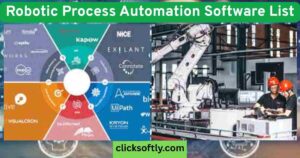
Best Robotic Process Automation Software (RPA) List, Uipath
Robotic Process Automation (RPA) has transformed the way businesses operate. Among the leading RPA tools, UiPath stands out. It offers powerful automation solutions for repetitive tasks. Let’s explore UiPath in detail.
Overview
UiPath is a popular RPA tool used by many businesses worldwide. It helps automate mundane tasks, freeing up valuable time. With UiPath, companies can improve efficiency and reduce human error. It provides a user-friendly interface and robust features.
Key Features
UiPath offers a range of key features. These include:
- Drag-and-drop interface: Easy to use for beginners.
- AI integration: Enhances decision-making.
- Scalability: Suitable for small to large businesses.
- Security: Ensures data protection and compliance.
- Extensive library: Pre-built templates and components.
Pros And Cons
UiPath has several advantages and some limitations. Let’s look at the pros first:
- User-friendly: Easy for non-tech users to understand.
- Community support: Large user base and forums.
- Comprehensive training: Offers free and paid courses.
Now, let’s consider some cons:
- Cost: Can be expensive for small businesses.
- Complexity: Advanced features may require expert knowledge.
- System requirements: Needs robust hardware for optimal performance.
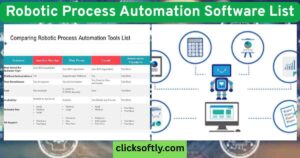
Automation Anywhere, Best Robotic Process Automation Software (RPA) List
Automation Anywhere is a top choice in the Robotic Process Automation Software List. It offers powerful tools to automate repetitive tasks. This software helps businesses improve efficiency and reduce human errors.
Robotic Process Automation (RPA) is transforming the way businesses operate, and Automation Anywhere is at the forefront of this revolution.
This powerful RPA software helps companies automate repetitive tasks, allowing employees to focus on more strategic initiatives. Let’s dive into what makes Automation Anywhere a popular choice among businesses.
Overview
Automation Anywhere is a leading RPA platform known for its user-friendly interface and robust capabilities. It provides a comprehensive suite of tools that enable organizations to automate end-to-end business processes.
Whether you’re a small business or a large enterprise, Automation Anywhere offers scalable solutions to meet your needs.
Key Features
Automation Anywhere is packed with features that make automation a breeze:
- Intelligent Automation: Leverage AI and machine learning to automate complex tasks.
- Bot Insights: Gain real-time analytics and performance metrics of your bots.
- Cloud-Based: Access your automation tools from anywhere, at any time.
- Bot Store: Download pre-built bots to accelerate your automation projects.
- Security: Benefit from enterprise-grade security to protect your data.
Pros And Cons
Automation Anywhere offers numerous advantages, but it’s essential to weigh them against potential drawbacks.
| Pros | Cons |
|---|---|
|
|
Have you ever wondered how much time you could save by automating mundane tasks? With Automation Anywhere, you can reclaim hours, if not days, of lost productivity.
Imagine focusing on strategic decisions rather than routine data entry. Give it a try and see how it transforms your workflow.
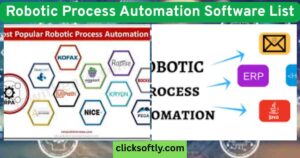
Blue Prism
Robotic Process Automation (RPA) has transformed the way businesses operate. One of the leading RPA tools in the market is Blue Prism. It’s widely recognized for its powerful capabilities and user-friendly interface. If you’re considering Blue Prism, here’s what you need to know.
Overview
Blue Prism is an RPA software that allows businesses to automate repetitive tasks. It is designed for large-scale automation and is used by many global organizations. The tool helps improve efficiency and reduce human error.
Using Blue Prism, you can create software robots that mimic human actions. These robots can interact with various applications, perform tasks, and make decisions based on predefined rules. It’s like having a digital workforce that works tirelessly 24/7.
Key Features
- Scalability: Blue Prism can handle large volumes of tasks across multiple departments.
- Security: It offers robust security features to protect sensitive data.
- Integration: The tool integrates seamlessly with various applications and systems.
- Analytics: It provides detailed analytics and reporting to monitor performance.
- Flexibility: Blue Prism supports both attended and unattended automation.
Pros And Cons
| Pros | Cons |
|---|---|
|
|
Have you ever thought about how much time your team spends on repetitive tasks? Imagine if you could free up that time for more valuable work. Blue Prism can make that possible.
By leveraging Blue Prism, you can streamline your processes and achieve higher efficiency. However, it’s important to weigh its benefits against the costs and learning curve. Is your organization ready to take the leap into automation?
Consider the specific needs of your business and how Blue Prism aligns with your goals. Investing in the right RPA tool can make a significant difference in your operational success.

Microsoft Power Automate
Microsoft Power Automate is a leading tool in the Robotic Process Automation (RPA) industry. It empowers users to automate repetitive tasks and workflows. This software integrates with many Microsoft and third-party applications. With Power Automate, users can streamline processes and improve efficiency.
Overview
Microsoft Power Automate helps automate tasks and workflows across different applications and services. It offers a user-friendly interface and a variety of pre-built templates.
Users can create automated workflows without coding skills. This makes it accessible to both technical and non-technical users. The tool also integrates with other Microsoft services like Office 365 and Azure.
Key Features
Microsoft Power Automate has several key features that make it a powerful RPA tool:
- Pre-built templates for quick workflow creation
- Integration with over 300 applications and services
- AI Builder for incorporating AI capabilities into workflows
- Custom connectors for linking to proprietary systems
- Cloud-based and on-premises deployment options
Pros And Cons
Like any software, Microsoft Power Automate has its pros and cons.
Pros:
- Easy to use with a drag-and-drop interface
- Extensive integration options with various apps
- Regular updates and support from Microsoft
- Scalable to fit small to large enterprises
- Good documentation and community support
Cons:
- Some advanced features require premium plans
- Performance may vary with complex workflows
- Learning curve for non-Microsoft users
- Limited offline functionality
- Occasional bugs and glitches

Trends In Rpa, Best Robotic Process Automation Software (RPA) List
Robotic Process Automation (RPA) is changing rapidly. Businesses are adopting RPA to improve efficiency and reduce costs. Keeping up with trends in RPA is crucial for staying competitive. Let’s explore some of the most important trends shaping the future of RPA.
Ai And Machine Learning Integration
AI and machine learning are becoming integral to RPA. These technologies enhance RPA’s capabilities. They allow RPA to handle more complex tasks. AI helps RPA software make better decisions.
Machine learning enables RPA to learn from data. This results in smarter automation processes. Businesses benefit from improved accuracy and efficiency.
Future Of Rpa
The future of RPA looks promising. RPA will continue to evolve with new technologies. Integration with cloud services will become more common. This will offer greater scalability and flexibility.
Businesses will leverage RPA for more advanced processes. The use of RPA will expand across various industries. Continuous advancements will keep RPA relevant and valuable.
Choosing The Right Rpa Tool
Selecting the right RPA tool involves exploring various software options. Key factors include ease of use, integration capabilities, and scalability. Popular choices often feature user-friendly interfaces and strong support.
Choosing the right RPA tool can significantly impact your business operations. With various options available, it’s essential to understand what to look for. The right tool can automate repetitive tasks, improve efficiency, and save costs. But how do you pick the right one?
Factors To Consider
When choosing an RPA tool, consider its ease of use. Is the interface user-friendly? Can your team quickly learn to use it without extensive training? These factors can save you time and money. Another aspect is the tool’s scalability. As your business grows, will the software be able to handle the increased workload?
Ensure the tool can adapt to your future needs. Also, look at the level of support and updates offered. A good RPA tool should come with reliable customer support and regular updates to fix bugs and add new features.
Cost Vs. Benefits
The cost of an RPA tool can vary significantly. It’s crucial to weigh the cost against the benefits. Consider both the initial investment and the long-term savings. For instance, a more expensive tool might offer better features that save time and reduce errors.
This can lead to higher productivity and cost savings in the long run. Think about the licensing model as well. Does it require a subscription, or is it a one-time purchase? Make sure the pricing aligns with your budget and expected ROI.
Choosing the right RPA tool is a big decision. By considering these factors, you can make an informed choice that benefits your business. What’s your biggest challenge when selecting new software? Share your thoughts below!

Frequently Asked Questions
What Software Is Used For Rpa?
Popular RPA software includes UiPath, Automation Anywhere, and Blue Prism. These tools help automate repetitive tasks efficiently.
What Is The Best Rpa Software?
The best RPA software includes UiPath, Automation Anywhere, and Blue Prism. These tools offer robust features and user-friendly interfaces.
What Are The Three Main Rpa Tools?
The three main RPA tools are UiPath, Automation Anywhere, and Blue Prism. These tools help automate repetitive tasks efficiently.
What Is The Easiest Rpa Tool To Learn?
UiPath is the easiest RPA tool to learn. It offers a user-friendly interface and extensive tutorials. Beginners find it intuitive and accessible.
Conclusion
Choosing the right RPA software can boost your business efficiency. This list offers various tools to suit different needs. Evaluate each option carefully.
Consider your specific requirements and budget. Start automating repetitive tasks today. Enhance productivity and reduce human error.
Stay ahead in the competitive market. Happy automating!



Leave a Reply